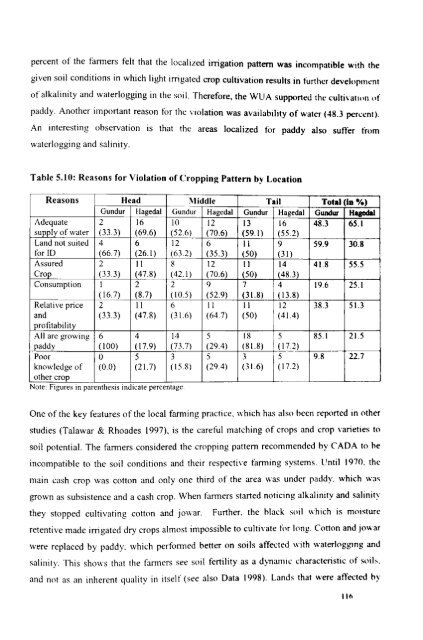Water Users Association and Irrigation Management - Institute for ...
Water Users Association and Irrigation Management - Institute for ...
Water Users Association and Irrigation Management - Institute for ...
You also want an ePaper? Increase the reach of your titles
YUMPU automatically turns print PDFs into web optimized ePapers that Google loves.
percent of the farmers felt that the localized irrigation pattern was incompatible with the<br />
given soil conditions in which light irrigated crop cultivation results in further developllll:nt<br />
of alkalinity <strong>and</strong> waterlogging in the soil. There<strong>for</strong>e, the WUA supported thl: cultivation of<br />
paddy. Another important reason <strong>for</strong> the violation was availability of water (48.3 percent).<br />
An interesting observation is that the areas localized <strong>for</strong> paddy also sutler from<br />
waterlogging <strong>and</strong> salinity.<br />
Table 5.10: Reasons <strong>for</strong> Violation of Cropping Pattern by Location<br />
Reasons Head Middle Tail Total (ID a/a)<br />
Gundur Hagedal Gundur Hagedal Gundur Hagedal GUDdur Hagedal<br />
Adequate 2 16 10 12 13 16<br />
supply of water (33.3) (69.6) (52.6) (70.6) (59.1) (55.2)<br />
48.3 65.1<br />
L<strong>and</strong> not suited 4 6 12 6 II 9 59.9 30.8<br />
<strong>for</strong> ID (66.7) (26.1 ) (632) (35.3) (50) (31 )<br />
Assured 2 II 8 12 II 14 41.8 55.5<br />
Crop (33.3) (47.8) (42.1 ) ( 70.6) (50) ( 48.3)<br />
Consumption I 2 2 9 7 4 19.6 25.1<br />
(16.7) (8.7) (10.5) (52.9) (31.8) ( 13.8)<br />
Relative price 2 I I 6 I I II 12 38.3 51.3<br />
<strong>and</strong> (33.3) (47.8) (31.6) (647) (50) (41.4)<br />
profitability<br />
All are growing 6 4 14 5 18 5 85.1 21.5<br />
paddy (100) (17.9) (73.7) (29.4) (81.8) ( 172)<br />
Poor 0 5 3 5 3 5 9.8 22.7<br />
knowledge of (0.0) (21.7) (15.8) (29.4) (31.6) ( 17.2)<br />
other crop<br />
Note. FIgures In parentheSIS IndIcate percentage.<br />
One of the key features of the local farming practice. which has also been reported in other<br />
studies (Talawar & Rhoades 1997), is the careful matching of crops <strong>and</strong> crop varieties to<br />
soil potential. The farmers considered the cropping pattern recommended by C ADA to be<br />
incompatible to the soil conditions <strong>and</strong> their respective farming systems. Until 1970. the<br />
main cash crop was cotton <strong>and</strong> only one third of the area was under paddy. which was<br />
grown as subsistence <strong>and</strong> a cash crop. When farmers started noticing alkalinity <strong>and</strong> salinity<br />
they stopped cultivating cotton <strong>and</strong> jowar. Further. the black s(lil which is mOIsture<br />
retentive made irrigated dry crops almost impossible to cultivate fix long. Cotton <strong>and</strong> jowar<br />
were replaced by paddy. which per<strong>for</strong>med better on soils affected with waterlogging <strong>and</strong><br />
salinity. This shows that the farmers see soil fertility as a dynamic characteristic of soib.<br />
<strong>and</strong> not as an inherent quality in itself (see also Data 1998). L<strong>and</strong>s that were affected bv<br />
116
















